Welcome to the Macoun Field Club!
The Macoun Club was established in May 1948 as a joint venture of the National Museum of Canada (Museum of Nature) and the Ottawa Field Naturalists’ Club; since 2010 it has continued under the sole sponsorship of the OFNC. This group is for children and teenagers aged 8 to 18. Activities normally take place on Saturdays during the school year.
Families can enquire about the Macoun Club at any time. Either phone Rob Lee at (613) 623-8123 (note that “Macoun” rhymes with “crown,” not “croon” — it is named for a famous Canadian botanist of the late 1800s), or e-mail him at Macoun[at] ofnc.ca. The Macoun Club is sponsored and supported by the Ottawa Field Naturalists’ Club (OFNC); there are no fees.
Autumn 2025 schedule
Indoor meetings alternate with field trips on Saturdays. Sometimes we hold two age-defined meetings in a morning, but usually a single, 2-hour meeting. At the Fletcher Wildlife Garden, there is parking nearby, but not at the building. See just below for more information on location and parking there. Some meetings are held at the St Laurent Academy.
Field trips will take place on the alternate Saturdays, typically from 10 a.m. until 3 p.m., all ages together. Details of exact times and locations are revealed only to families that either contact Rob on the Thursday or Friday before the trip, or register online once their child is registered as a member.
Schedule of events
Nov 15: Field trip. Watch for an e-mail from Rob on Thursday evening, or get in touch with him
Nov. 22: Indoor meeting
Nov. 29: Field Trip
For further information, contact Rob for details (and to register for trips). You can reach him at 623-8123 or e-mail him at macoun@ofnc.ca. Exact hours and locations of field trips are provided only when registering for them.
LOCATION, AND PARKING FOR MEETINGS: Except for special occasions, we meet in Building 138, the “OFNC – Interpretive Centre,” as it appears at a Google Maps pin, the building at the very end of the lane running east to the Fletcher Wildlife Garden from Prince of Wales Drive, the lane across the road from a big parking lot for the Agricultural Museum. There is no parking for parents at Building 138, or under the trees along the lane; if you want to stay while your child is in the meeting, park in the areas designated between the baseball diamond and the first building you come to, no. 136.
For families that remember how it was before, this year Agriculture Canada will ticket cars parked under the trees along the lane to Building 138, as it is considered an emergency-access route.
See what we did last year

In the outdoors, dispersal reduces the concentration of troublesome particles, be they cattail fluff or respiratory droplets
Where we are now with respect to Covid-19
Most people feel we have moved past the Covid-19 pandemic. But people are still contracting the virus; they just aren’t getting as sick.
Our general impression is that Covid-19 is now treated like other contagious respiratory illnesses — people should stay home when sick, but there are no longer specified periods of isolation.
We will not have to wear masks indoors, but you will see that some of us will be doing so in order to protect others from any respiratory illness they might have, or because of personal vulnerabilities. Outdoors, we do not consider masks necessary at all.
Here’s what we’ve done so far this year:
October 4, 2025: Tips on nature collecting
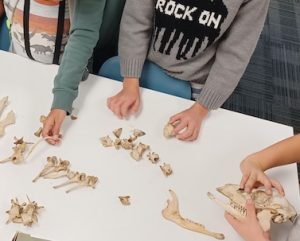
What is it? Macoun members working out the parts of a deer’s skeleton
In a meeting held at Mike Leveille’s school, Mike presented a series of hand-on collecting tips. Having an organized collection that one can learn from — or use to teach — involves preparing specimens (as in pinning butterflies) and having a place dedicated to their display or usefully accessible storage. Some naturalists fill display cases or cabinets, or even just shelves in a bookcase.
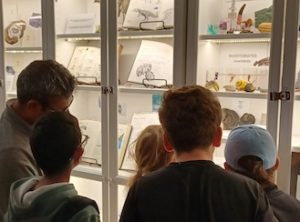
Mike’s best and most informative specimens on display
To keep track of specimens that soon become too numerous to remember readily, writing a number on the piece of rock or bone, or the cardboard a lichen or plant specimen is fastened to is matched by a numbered list of specimens. As one lichenologist told Rob Lee, “You can never have too many notes!” He meant that in addition to a name, it is wise to record the date and place where the item was found, and any special circumstances.
Mike explained some of the methods one can use in mounting specimens and had Macoun members practise some of them on material he provided.
September 20, 2025: Nature-art workshop
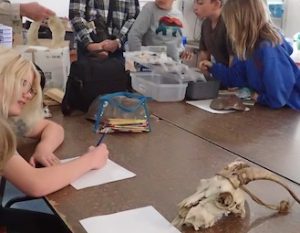
Macoun Club members sketched freely for an hour or more
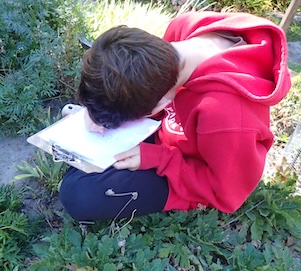
Giving close attention to detail
Some Macoun Club members are always working with pencil and paper, drawing things while observing in nature, while other people are talking, while listening to invited experts giving presentations. Today we gave everyone free run to draw whatever they wanted: we handed out pencils and paper to 20 members, and offered a selection of specimens to work from. (We had wolf, goat and lizard skulls, horseshoe crab shells, among other things.) Some went outside and drew directly from nature in the Backyard Garden.
The results will be published in our own magazine, The Little Bear, next year.
September 13, 2025: Return to our Nature Study Area
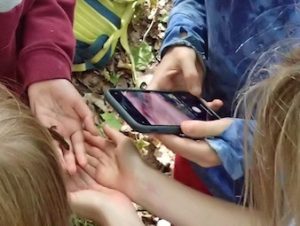
Everyone is eager for hands-on experience
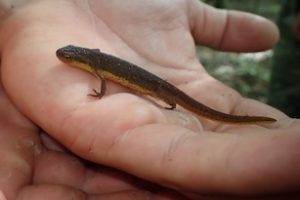
Eastern Newt in hand
How has our Study Area fared during the summer drought, which continues even now? In the past (2001 and 2012) trees on shallow soil over bedrock died from lack of water, changing the character of whole sections of forest. This time the foliage of a few small trees has turned brown, and only small groves have died. Deeper forests, like our Study Tree Woods, are green, top to bottom. On the other hand, the forest floor is still covered with last year’s fallen leaves, indicating that it had not been humid enough for Dew Worms to come out even at night to eat them. Under logs today, we readily found salamanders, but few earthworms.
In fact, we turned up lots of salamanders — Blue-spotted, Red Eft, and Eastern Newt — almost anywhere we looked. And Wood Frogs were out and about.
In the trees overhead were Porcupines, usually high in the canopy of Red Oak trees. But one, a baby of the year, was right down on the hiking trail — a passing jogger merely swung wide around the animal.
We checked out a forgotten pioneer orchard and found only three apples — which we can again attribute to dryness. We had lovely weather for being out, but the natural environment is stressed.
September 6, 2025: Getting to know each other
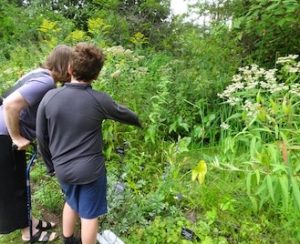
Macouner pointing out a Green Frog in the pond
A summer’s worth of observations to share! We gathered at the Fletcher Wildlife Garden and heard about nature sightings from members we’ve known for years and from kids who had never been with us before. Some had travelled, more than one family to Newfoundland, and one boy to Vancouver Island’s West Coast Trail. Niccolo and Mattia had been to Italy. We heard about crabs and seagulls, jellyfish and eagles. One new boy had made drawings of the insects he wanted to tell us about. Some members showed photos. And then leader Mike Leveille challenged the group to find the Eastern Gray Treefrog he had spotted on the outside of the building. Everyone charged outside, found it, and then soon we had a second amphibian in sight (a Green Frog in miniature pond), and then an American Toad beside the Garden’s Prickly Pear Cactus plant. Everyone could see the Chipmunks running around in the “Backyard Garden” and a few people followed the sound to a Red Squirrel gnawing on a tough Black Walnut. This is how we get to know each other.
It was hard to get everyone back inside, but we wanted to have Mike explain how he will trade members for natural history specimens he carries in his portable Swap Shop. We can trade several common objects for one less common thing, and some of them for things of some rarity. There are four levels.
Here’s what we did last year:
June 28, 2025: Winding up with our annual party
Our year’s final meeting began as usual, with the President calling for order. We shared observations and comments, then moved to the presentation of awards. New members whose participation merited recognition received a badge, and a dozen who have two or more years behind them were given Badge Winners’ Honour Circle certificates — personalized cards featuring some aspect of their experience. The Little Bear had been printed, and every member present received a copy. Finally, we showed the Bill Mason Film, “Rise and Fall of the Great Lakes.” It has been our favourite since 1967.
June 21, 2025: Some in the water, and some out of it

Exploring the falls after lunch
On a particularly warm, sunny day, we knew just where to go: “the waterfall” at Gerry’s. To get there, we took the old, familiar trail under the big pine, past the sandpit, and over the troll-bridge; then up over the long, big hill, and back down — pausing to pose in front of Gerry’s trail camera — and then, searching back and forth, Where do we turn off?

16 people filed by the turtle . . .
Everything has changed in recent years. Whole groves of big trees have blown down and lie in a tangle across the old footpath, and more have fallen across the new one, too. And with so much sunlight now flooding in, new growth has surged up to conceal the old forest aisles.
Even so, Rob and Peggy had a good sense of where the right and least hazardous route lay, and soon we were spreading out over the bare rock by the falls, eating lunch. By and by, Macouners began to explore — upstream on both shores, and downstream, eventually wading out into the pool below. Several kids got out masks and goggles and searched that pool for fish. Hugo reported Rock Bass, Pumpkinseed sunfish, and Creek Chubb. And crayfish. There might have been more, except that it is a favourite haunt of a Kingfisher — we heard its rattling cry when we arrived.

. . . and the turtle didn’t bat an eye
Rob stuck his feet into his favourite pool — the one above the falls — and partly blocked the flow. Former member Aidan sat in that gap and plugged it, shutting off and turning on the falls at will.
Afterward, we returned to the trail and headed for Gerry’s cabin. All switching to one rut, we filed past a large Blanding’s Turtle in the other, which hardly batted an eye.
Gerry engaged us in conversation while those keen on skulls and bones probed his trapper’s bone pile — rabbit, raccoon, and deer. Gerry commented on how low the water level was. No wonder the falls had seemed so gentle.
June 14, 2025: The signs of an Ice Age are all around us

The Geological Survey of Canada has produced a series of maps showing the extent of the last glaciation
During the last Ice Age, Canada was covered with a continental glacier. Rob opened a huge map on the table, and we could see that only little bits of what we know as Canada were sticking out — in Nova Scotia (Cape Breton), PEI, and the Yukon. As our favourite NFB film says, it was “a mile thick and moving slow.” But if you had to prove it to someone, what could you point to today?
On our field trips, to our Study Area and Pakenham, we are often seeing signs of that vanished glacier. Bedrock scoured smooth and left bare, with no covering of soil. Boulders that the moving mass of ice plucked out of that bedrock, and dropped on top of quite different rock when it melted away — “glacial erratics.”
Even small rocks — pebbles and cobbles — were scraped and shaped within the moving ice into distinctive patterns (typically with a top and bottom, and about five flat sides around the edges). One of the rocks Rob brought in was relatively soft, and it bore scratches from other, harder rocks the ice had pressed against it. You can see such scratches, called striations on bedrock, too.
Then Rob played “Rise and Fall of the Great Lakes,” stopping and restarting it repeatedly to name the landforms that speak so eloquently of the Ice Age: eskers, moraines, and drumlins.
May 31, 2025: Never lost but lots of finds

Spider nest with new hatchlings
A lot of our field trips take place in the Study Area, but no matter how often we go there, we always make new discoveries and today was no exception. Why did the Porcupine cross the path? To get to the tree on the other side of course! Luckily Peggy spotted it on its crossing and we were all able to see it climb the tree. Macoun members love Porcupines.
Niccolò found a nest of baby spiders suspended in the tall grass and an Eastern Tent Caterpillar. Others found a June bug (genus Phyllophaga) and a millipede, and Rhys found a little Red Eft. Our mushroom finds included Scaly Ink Cap (Coprinopsis variegata), Purple-and-White Deceiver (Laccaria ochropurpurea) and a type of oyster mushroom that we could not positively identify to species. Bloodroot was no longer flowering but Rob spotted the leaves and showed Macouners the red ‘blood’ within its stem. False Solomon’s Seal (Maianthemum racemosum) and lots of honeysuckles were in full bloom.
Hugo found a Red Pine “flower” which isn’t actually a flower but a cluster of male cones that are only around in the spring and which contain the pollen that gets carried by the wind to the young female cones that develop into the cones we are more familiar with seeing. These cones contain the bare seeds that eventually get dispersed or eaten by hungry squirrels and other critters.
May 24, 2025: From tender green leaves to leaf-like eel larvae

Rob showing how tender new leaves bruise when stepped on
Following up on an episode on the last field trip, Rob laid some fresh green leaves on the floor and, in front of everyone, trampled on them. The leaves bruised dark green. At Pakenham, on May 3rd, Rob had put some of our youngest members on the trail of strangers in the woods. He taught them to see the delicate new spears of Canada Mayflower leaves that had been bent over, bruised, and even torn loose by the strangers’ boots. They followed easily for 10 minutes.
Rob said that Macouners can teach themselves to be trackers, and maybe someday help find missing people in the woods. (In Nova Scotia this month, two small children went missing the day before our field trip; shortly before today’s meeting, the standard format search was called off. They were never found. Yet the woods there were full of Canada Mayflower leaves, just like ours.)

Photo of Rory Hogan giving talk on Eels
Then our speaker, Rory Hogan (Macoun member from 2013-2019) launched into a topic eagerly awaited by our current members: eels. Rory is a student at Dalhousie University in Nova Scotia, and has caught eels on class field trips to Nova Scotia rivers and studied them in the lab. He dwelt on the larval stages of the eel — leptocephalus, glass eel, elver, and yellow eel — but the heart of his talk concerned the evolutionary relationship between two sister species, the American Eel and the European Eel. It all went back, he said, to the rise of the Gulf Stream three million years ago. The new ocean current carried the larvae north; some ascended the rivers of northeastern North America, and some the rivers of northern Europe. They both return to the Sargasso Sea to breed, but somehow each sees itself as different from the other.
May 10, 2025: Have you ever found a bird’s nest?

After the talk: speaker Denis Burchill with his friend from 50 years ago with Macouner Ace
Lots of people birdwatch — go out with binoculars to find and identify birds. But former Macoun Club member Denis Burchill (1969-71) got into birds by first finding their nests. The nest is the primary focus of a bird’s life and finding it often brings the observer into the closest contact with it, as parent birds usually guard their eggs and nestlings from even well-meaning observers. At other times, a bird’s best defence is to either sneak away from a well-hidden nest, making for a challenging search.
Denis credits fellow Macouner Rob Lee with having him introduced him to the Quebec Nest Record Scheme back in 1970 (Denis then lived in Aylmer). This was a government-run program that used standardized data cards to enable even teenagers to contribute their observations to the fund of scientific knowledge. Today, nest observations can be submitted through Project NestWatch.
April 12, 2025: Geology and paleontology of Nova Scotia

Mike brought his prize fossil specimens around to each of us
Mike Leveille visited Nova Scotia last month, and returned with a fine collection of fossils. We met at his school, the St. Laurent Academy, where he had outlined the geology of the province on a classroom whiteboard. The Carboniferous period is represented by wonderful specimens at Joggins Cliff. This famous site is strictly controlled by a government permit system, so Mike acquired his specimens from an authorized shop. These he brought around one by one, so we could examine them and feel their texture while he related them to artists’ conceptions of the original organisms.
Mike had also taken a walk along the early spring seashore and visited Dalhousie University’s “touch-tank” and showed us videos he had made of the creatures he encountered.
March 22, 2025: Impassable tangles and white-out
Trying to schedule a field trip in between bouts of bad weather, Rob planned a short 2-hour trip to the Study Area’s Sarsaparilla Trail after lunch. We had the best turnout in months — and finished with some of the worst weather after all. What made it particularly trying was the way that part of our Study Area had become overgrown with buckthorn shrubs and almost impassable. Rob tried the ice of the pond and got a soaker. We had started with mild temperatures (6ºC) but the few of us who stayed beyond the scheduled ending found ourselves driving home in white-out conditions.
February 22, 2025: What hard and solid natural object is never fossilized?
An icicle! Rob passed around a big one, as long as his forearm, that had grown down from his eavestrough. It was clear ice, smooth to the touch, and sculpted. It had also been shrinking day by day, Rob said, even though the thermometer hadn’t got above freezing in weeks. If it wasn’t melting, how could it be getting smaller?
“Sss . . s . . . sublimation?” ventured Kaylee. “Yes!”

John Macoun discussing bird nest with boy
Rob went on to describe how water molecules in the ice can jump straight from the solid state to the gas (water vapour). The same thing happens to minute snowflakes, too, except that within the confines of a snowpack, the water molecules switch back and forth between the solid and the gas. Pointy bits wear away, and rounder parts grow, gradually turning classic, six-pointed snowflakes into lumpy snow grains by spring. This is also the process, much accelerated, that rapidly turns heaped up, loose snow piles into solid structures. Hugo told us he’d just been camping in a quinzhee he and friends had made on a winter camping trip, and the roof — loose snow just the day before — became strong enough to walk upon next morning.
Rob also gave a brief talk on John Macoun, exhibiting the huge photographic portrait we have of this man — in honour of Macoun’s great-great-great-grandson being in attendance.
And Mike, preparing the group for the launch of his travelling Swap Shop, introduced us to the need to pay attention to the rules around collecting. There are legal restrictions, of course, on trading in endangered species (including Monarch butterflies now!), but also on certain fossils from rare and limited collecting localities.
No laws on icicles.
Feb. 8, 2026: Wildlife of the Antarctic seas

Roy showing with his hands how big the head of a Royal Albatross really is
What wildlife? Rob introduced this once-absurd notion with a reading from the authoritative Encyclopedia Britannica, 9th edition (1878): “It is clear that the cold and the dangers of the southern ocean greatly exceed those of the northern, and that human beings and most other animals cannot, or at least do not, ordinarily subsist within its limits.”
Roy John has been there twice; we had a foretaste of his encounters with wildlife when he was talking about the historical figure of Ernest Shackleton two weeks ago. Now his pictures were all of birds — gulls and fulmars, petrels and albatrosses, and, of course, penguins — as well as seals, sea lions, and whales. A lot was discovered in the years after 1878. Emperor Penguins, he said, had replaced Adelies as his favourites.
Roy, too, had his adventures: he recounted being seriously chilled on a shore expedition.
Feb. 1, 2025: Lunch at Rock-wall Pond

Macouners leaving the sunny pond behind
On a winter day with the temperature topping out at -14ºC, we know just where to go at Pakenham: Rock-wall Pond. It was well frozen, and covered with about 8 inches of snow. We marched past the beaver lodge and hooked right into a bay where the sun pours in and the north and west winds are blocked. There we can eat barehanded. Hugo got his fire going with flint-and-steel, Rob’s matches blew out and he accepted the use of lighter.
As kids finished eating, they began racing each other on snowshoes, kicking up rooster-tails of snow. (Modern, ‘high-tech’ snowshoes are like that — they’re fixed to the foot, not hinged like traditional snowshoes.)
From there, Rob led off through the pine woods and down to Indian Creek where it passes below Gerry’s cabin. Remembering Gerry’s old carcass pile from the days when he was a trapper, Macouners dug down through the snow and pried up skulls and other bones that were frozen to the soil.
Not surprisingly, we were 20 minutes late coming out of the woods.
Jan. 25, 2025: Whatever happened to Shackleton’s ship?

Antoine and Roy at the meeting
One of our Macoun Club parents, Antoine Normandin, was a key figure in the recent discovery of the wreck of Ernest Shackleton’s last ship. Who was Shackleton?
To answer that, Rob called upon Roy John, because he knew that in his youth (and even now, 60 years later) Roy held Shackleton as a hero. In the days of sailing ships, Shackleton had led an expedition into the Antarctic Sea. His ship, the Endurance, was caught in moving ice, was crushed, and sank. Before it went down, Shackleton led his crew over the broken-up ice to a small island. Leaving his men under a tarpaulin, Shackleton navigated a lifeboat a thousand miles to a little pinpoint of land where he secured help, organized a rescue, and retrieved his men.
But that wasn’t Shackleton’s last ship. He tried again a few years later in the Quest. Shackleton had never lost a man, but he himself died onboard and was buried on the same island he’d reached in his epic voyage in a small boat. Roy has been to his grave.
The Quest went on for another 30 years, got caught in sea ice off Labrador, and sank. In 2024, Antoine did the research that established the search area. For us, he described with energy and intensity what he had to do, and how the actual search with side-scanning sonar progressed. When the images of the wreck appeared, the smooth sea floor 390 metres down was scored by thin, straight lines, and sparsely dotted. The lines, Antoine said, were left by drifting icebergs dragging on the bottom, and the dots are craters where Greenland boulders, fell out of such huge icebergs and plumped down into the ooze.
January 11,2025: How to find your way in the wild places

Former member Priya explaining the workings of a compass
Would you use a compass? Half of our members have one. Rob asked, “Does anyone look at it before setting out?” No.
With or without a compass, when everything is going well, it is wise to stay constantly aware of your surroundings, whether you’re on a well beaten path or off-trail. Take note of any turns taken, and look back from time to time to see what it’ll look like going home.
If you do get a little “lost,” make a plan. Rob described how he has turned random trees into landmarks by leaning sticks against them upside-down, and used them to organize his search for familiar terrain.
If you have gotton seriously lost, remember that someone will be looking for you. Leave messages for them in writing. Best is to write your name and the time on flagging tape with a marker pen. But you can dab mud on birch bark, scratch your intials in the dirt, even write on the bottom of an Artist’s Conk bracket fungus and leave it where it will be seen.
And if you do have a compass — look at it before you set out.
December 14, 2024: Return to “California”
We repeated our trip of two weeks ago, this time seeing the tracks of wild animals in the thin layer of snow that had fallen. Mozz exclaimed, “Six kinds in 14 minutes!” But we never saw any of the actual animals — deer, fox, mouse, fisher, red squirrel and grouse.
At lunchtime, we lit our fires in the same rings of stone as before, on a rocky slope over a beaver pond surrounded by rock and forest. Remembering how thin the ice had been two weeks earlier (a quarter-inch) no one ventured out on it until Rob led the way. He showed how bubbles trapped in the ice showed it was now five inches thick. He cleared a sliding place and introduced everyone to the game of running and sliding to see who could go furthest. Fisher bested everyone, including Rob, going 50% further.
December 7, 2024: How many ways are there to study a tree?

Barbara Gaertner by her “SE Maple” in 2008

Barbara with her tree nearly 20 years later (2025)
Rob launched the Study Tree Project in 1991, and told us that he has seen Macouners approach their chosen trees from many angles: the scientific (measurement), as natural history (when does it leaf out in the spring and change colour in the fall?), and artistic (drawings and photography). But we’ve only been able to make educated guesses about our trees’ ages.
Leader Barbara chose a damaged Sugar Maple that first year (it had been attacked by both a canker-forming fungus and a porcupine). In the photos, you can see it’s the same tree by the rock beside it. Though rot has deepened and bark fallen away, the tree has so far braced itself with massive new wood up one side. It is definitely still alive and vigorous.
Today Rob brought in an “increment borer,” a hollow drill that one cranks into the trunk to obtain a tiny cross-section of the annual rings — which can be counted to get the age. He also had two fist-size blocks of wood, one from an old-growth Western Red Cedar with millimetre-wide rings that took a hundred years to grow, and another from an eastern spruce with rings as wide as a fat pencil that took only 10 years. The old-growth wood, he explained, had been soaked in the trees own natural juices and was extremely rot-resistant; block cut from a fast-growing sapling would rot just as fast as it grew, except that it had been industrially treated with toxins. We get most of our lumber from fast-grown trees.
November 23, 2024: What are we interested in?

Macoun member choosing from among seashells
We tackled some long-overdue Club business: we held elections to decide who would bring meetings to order (the president, Alma), introduce speakers (VP Hugo), and record our meetings (secretary Mozz).
Rob asked everyone to fill in a new registration form, to better gauge their current interests. Tamsin circled “Birds” 10 times. Both Owen B. and Layla added a subject not on the list: “Mushrooms,” and Mozz, “Climate Change.” Hugo was outspoken among the several members wanting to develop their “Outdoor skills.” Asked if anything else was important, Ruth wrote: “having fun!”
Then Rob literally opened a subject not on anyone’s list: boxes and boxes of seashells. He said each member could choose one specimen each to take home, and as we looked through them, he provided some natural-history information on each selection.
November 16, 2024: The fossil pile is breaking up!

Spreading out over the shale piles

Splitting shale with hammer and cold chisel
At the request of members, and Mike Leveille’s urging, we made a return to the shale heaps at Beechwood Cemetery near his school. This is the Billings Shale, which comes from a black layer in the local grey limestone, and it’s full of fine fossils from 440 million years ago – nautlioids, trilobites, graptolites and tiny inarticulate brachiopds. But the blocks of shale have been weathering for several years now, crumbling to powder, and good finds are becoming fewer.
Macouners now know to bring hammers and safety goggles, and worked for an hour and more splitting the remaining rocks apart. Nautiloids were everywhere, trilobites were scarce, and the other types quite scarce.
Back at his school, Mike also opened his cabinet doors and took in members’ specimens in trade for others of equal value.
November 9, 2024: When wild birds are hurt and need help . . .

Patty McLaughlin laying out specimens

Macoun Club members handling wings of birds that couldn’t be saved
When Rob Lee was a Macoun member, there was no one to take in injured birds and rehabilitate them. He had to do it himself, and successfully released a small number of birds that couldn’t fly for a month because of sprained wings.
Now, people are able to take the birds they find to the Ottawa Valley Wild Bird Care Centre. Drawing on decades of experience, baby birds can be raised until they can be on their own, injured birds are healed an released, and those whose injuries leave them crippled have a place to stay. One such is a small falcon, a Kestral with a badly-healed wing, too stiff for flight.
The Centre’s Education Program Manager, Patty McLaughlin, began with a series of photos and short video clips of the birds that have come in for care, and then, telling us that not all birds survive their injuries, passed around specimens for our examination (held under federal permits).
She even brought in the Kestral in a large cage. She fed it while we were there, which set it at ease in such a crowded room.
November 2, 2024: Late autumn in the Pakenham Hills

Lunch by a favourite beaver pond
On a perfect late autumn day, we followed an old bush road into familiar places, coming at last to the floating bog we visited on September 21st. But no one really wanted to wade out there at this season: we have had some hard frosts and the water was cold.
It was better on land, lounging in the sunshine, sitting by a campfire. Following our October 5th trip, some were keenly interested in mushrooms. Others wrestled each other to the ground and tumbled around head over heels. Only one salamander (Red-backed) was found, despite many logs being turned.
Continuing off-trail, Rob led over the hill to Indian Creek at a point where we could look across the water to Gerry’s cabin. And we finished up there. Gerry had been waiting for us – he had found a mummified baby turtle, and when the kids ran off looking for bones, he engaged the adults in conversation.
October 26, 2024: The arms race among the animals
Why is a turtle like a porcupine? Answer: they both wear body armour for protection against predators.
Why does an adult Snapping Turtle wear such heavy, awkward armour? Answer: for protection against other snappers when males fight each other.
What do pillbugs, water bears, and toads have in common? Answer: lightweight but tough armour against dry and hostile environments (they keep the water in).

In the beginning . . . Robbie Stewart and one of his slides
These were the basic questions that former Macouner Robbie Stewart explored through a survey of paleontological time, from the idyllic Ediacarian times when there were no predators, through the time of the dinosaurs, right down to today’s world. With his great interest in paleontology, there were lots of impressive giants from past geological eras, often with a human figure superimposed for scale.
And with the development of armour comes the evolution of bigger teeth and stronger predatorial jaws. Or evolution can go off in a new direction: fish no longer need armour because they can outswim their predators.
For an hour-and-a-half it was question and answer, back and forth, between our speaker and our members.
October 19, 2024: One last look at the foliage

Macouner letting a Garter Snake calmly glide through his fingers
Even on the short (200 m) walk through the woods to our Study Area proper, we started seeing wildlife. First there was a Barred Owl (see photo for Sept. 28th), which flew away from us, and then a Porcupine high up in a tall Red Oak. Under logs, we found Blue-spotted Salamanders.
From long experience we knew that the leaves would soon be off most of the trees, so we hurried to our Study Tree Woods to experience the forest in its colours. Already one was bare! – Corbin’s Yellow Birch. But most our trees shared the general yellowish-green of the canopy. There is very little red anymore, as a minute fungus has spoiled the leaves yet again. Even Sugar Maple leaves turn yellow and brown, with hundreds of tiny black dots.
While new members were choosing trees and making notes, and while Rob was helping measure the heights of the trees (with a homemade “hypsometer”), sharp-eyed Macouners were finding salamanders (Red Eft and Blue-spotted), frogs (a fingernail-size Eastern Gray Tree Frog) and snakes (just one, a Garter).
When we had eaten lunch and felt we’d exhausted the possibilities in this special hardwood forest, we circumnavigated the adjacent Woodland Pond. A metre deep in spring, the sedgy bottom now looked dry, but the basin’s peaty bottom was sopping wet and we skirted it by keeping to the floodplain fringe of Red and Silver Maples.
It’ll be weeks before we return, and the maples will have shed their leaves, but the oaks and maybe even the beeches will have kept theirs.
October 5, 2024: Mushroom blitz

Chlldren using a pocket mirror to check for gills on the underside of an Amanita citrina mushroom

Mushroom hunters Joan Heyding and Lynn Ovendon discussing Macouners’ finds
How many kinds of fungi might there be in our Nature Study Area? That’s a long-term project; since 2005 we have recorded 84 species, most of them mushrooms. Today we focused on one tiny part of the square mile, the moist border between a rather dry mixed forest (pine and red maple) and a young cedar woods near parking lot P6.
It was all highly organized, with five experienced mushroom hunters each taking under their wings five Macoun Club members: see what you can find in an hour. For beginners, the goal was to discover one example of a mushroom with gills underneath, or pores, or teeth; mushrooms of different colours (white, red, blue); and fungi of different structure (toadstools, brackets, cups, crusts, coralline growths).
When the hour was up, all the finds were brought to a long table set up in the woods and subjected to examination and discussion. The final total is still being tallied.
After lunch, Rob led away through a buckthorn jungle in which Macouners found animals skulls and bones lying on the ground. Then we broke out into a wide expanse of bare rock and bright sunshine. Onward into the woods on the far side — there were Blue-spotted Salamanders under logs — and up a long, long trail to our Study Tree Woods. There, new trees were chosen, and old ones revisited after a summer’s absence. We got out to parking lot P6 only a little late.
September 28, 2024: The outdoors was a bigger draw than indoors

Barred Owl taking flight
Rob had plans for a talk, but it was too fine a day to stay indoors, especially when kids were coming in with three snakes at time, or parents reporting an owl on the grounds of the Fletcher Wildlife Garden. We went out and found it by asking people we met along the trail — most were hanging back lest they stress the bird. It proved to be a Barred Owl, fully awake at noon and looking around from its post. There were Blue Jays around, but they did not seem to have found it (Jays yell a lot and will sometimes tweak a Barred Owl’s tail in a quick flyby).
Sept. 21, 2024: Early autumn at Pakenham
 It was a very full day. We walked away from the cars and down a familiar old bush road, finding one salamander (Red-backed), one snake (Garter), and a number of frogs (Green, Leopard, and Wood). Arriving at Gerry’s cabin, we had lunch and scavenged animal bones (Blue Jay, Striped Skunk, Deer, Moose (?), and Raccoon) from the rock where he deposits dead animals he has come across (to feed scavengers like Raccoons, Ravens and Turkey Vultures).
It was a very full day. We walked away from the cars and down a familiar old bush road, finding one salamander (Red-backed), one snake (Garter), and a number of frogs (Green, Leopard, and Wood). Arriving at Gerry’s cabin, we had lunch and scavenged animal bones (Blue Jay, Striped Skunk, Deer, Moose (?), and Raccoon) from the rock where he deposits dead animals he has come across (to feed scavengers like Raccoons, Ravens and Turkey Vultures).

Is it a stickleback?
From there we moved to a floating bog, waded across the moat, and explored its features. This is the bog featured in our banner picture at the top of this page. Niccolo caught a small minnow in a bog pool (which is open to the wider pond underneath the floating mat of peat) and released it.
We finished up by relaxing at a gentle waterfall on Indian Creek, where we could stretch out on an expanse of clean rock.
Sept. 14, 2024: First meeting of the year
Rob and Mike talked about keeping notes on what we see in nature — Rob passed around his homemade pocket notebook from when he was 14 years old, and a copy of a finished Nature Journal, bound in hardcover. We moved on to sketching subjects from Mike’s nature displays, and took advantage of Mike’s “Swap Shop” to trade for fossil specimens.
